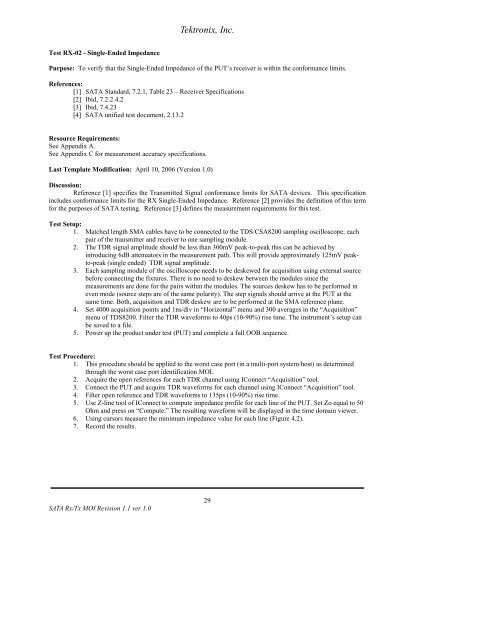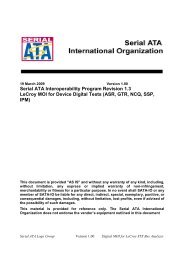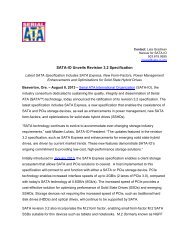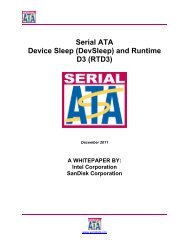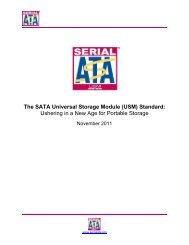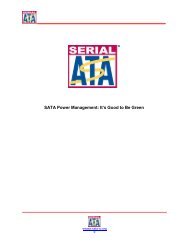1.0 - SATA-IO
1.0 - SATA-IO
1.0 - SATA-IO
- No tags were found...
Create successful ePaper yourself
Turn your PDF publications into a flip-book with our unique Google optimized e-Paper software.
Tektronix, Inc.Test RX-02 - Single-Ended ImpedancePurpose: To verify that the Single-Ended Impedance of the PUT’s receiver is within the conformance limits.References:[1] <strong>SATA</strong> Standard, 7.2.1, Table 23 – Receiver Specifications[2] Ibid, 7.2.2.4.2[3] Ibid, 7.4.23[4] <strong>SATA</strong> unified test document, 2.13.2Resource Requirements:See Appendix A.See Appendix C for measurement accuracy specifications.Last Template Modification: April 10, 2006 (Version <strong>1.0</strong>)Discussion:Reference [1] specifies the Transmitted Signal conformance limits for <strong>SATA</strong> devices. This specificationincludes conformance limits for the RX Single-Ended Impedance. Reference [2] provides the definition of this termfor the purposes of <strong>SATA</strong> testing. Reference [3] defines the measurement requirements for this test.Test Setup:1. Matched length SMA cables have to be connected to the TDS/CSA8200 sampling oscilloscope; eachpair of the transmitter and receiver to one sampling module.2. The TDR signal amplitude should be less than 300mV peak-to-peak this can be achieved byintroducing 6dB attenuators in the measurement path. This will provide approximately 125mV peakto-peak(single ended) TDR signal amplitude.3. Each sampling module of the oscilloscope needs to be deskewed for acquisition using external sourcebefore connecting the fixtures. There is no need to deskew between the modules since themeasurements are done for the pairs within the modules. The sources deskew has to be performed ineven mode (source steps are of the same polarity). The step signals should arrive at the PUT at thesame time. Both, acquisition and TDR deskew are to be performed at the SMA reference plane.4. Set 4000 acquisition points and 1ns/div in “Horizontal” menu and 300 averages in the “Acquisition”menu of TDS8200. Filter the TDR waveforms to 40ps (10-90%) rise time. The instrument’s setup canbe saved to a file.5. Power up the product under test (PUT) and complete a full OOB sequence.Test Procedure:1. This procedure should be applied to the worst case port (in a multi-port system/host) as determinedthrough the worst case port identification MOI.2. Acquire the open references for each TDR channel using IConnect “Acquisition” tool.3. Connect the PUT and acquire TDR waveforms for each channel using IConnect “Acquisition” tool.4. Filter open reference and TDR waveforms to 135ps (10-90%) rise time.5. Use Z-line tool of IConnect to compute impedance profile for each line of the PUT. Set Zo equal to 50Ohm and press on “Compute.” The resulting waveform will be displayed in the time domain viewer.6. Using cursors measure the minimum impedance value for each line (Figure 4.2).7. Record the results.<strong>SATA</strong> Rx/Tx MOI Revision 1.1 ver <strong>1.0</strong>29


